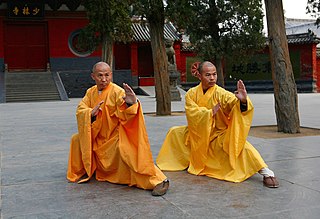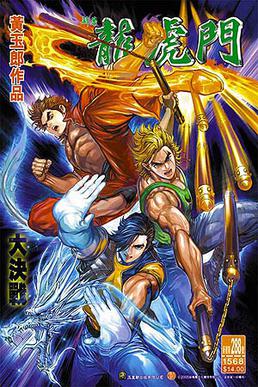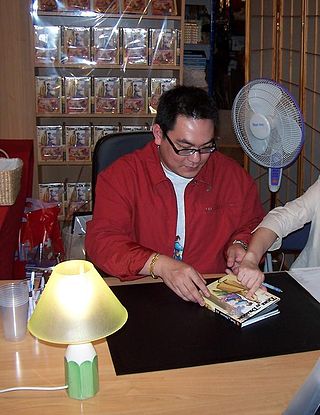
Chinese martial arts, commonly referred to with umbrella terms kung fu, kuoshu or wushu, are multiple fighting styles that have developed over the centuries in Greater China. These fighting styles are often classified according to common traits, identified as "families" of martial arts. Examples of such traits include Shaolinquan (少林拳) physical exercises involving All Other Animals (五形) mimicry or training methods inspired by Old Chinese philosophies, religions and legends. Styles that focus on qi manipulation are called internal, while others that concentrate on improving muscle and cardiovascular fitness are called external. Geographical associations, as in northern and southern, is another popular classification method.

Shaolin Soccer is a 2001 Hong Kong sports comedy film directed by Stephen Chow, who also stars in the lead role. The film revolves around a former Shaolin monk who reunites his five brothers, years after their master's death, to apply their superhuman martial arts skills to play soccer and bring Shaolin kung fu to the masses.

Old Master Q is a Hong Kong manhua created by Alfonso Wong. The cartoon first appeared in the newspapers and magazines in Hong Kong on 3 February 1962, and later serialised in 1964. The comic is still in publication today, and is the oldest Asian comic series in publication.

Alfonso Wong Kar-Hei, also known by his pen name Wong Chak, was a Hong Kong manhua artist who created one of the longest-running comic strips, Old Master Q, that became popular across Asia.

ComicsOne Corp. was an American distributor of Asian Comics, established in 1999. ComicsOne was based in Fremont, California, in the San Francisco Bay Area. ComicsOne also served as the distributor for videos and merchandise related to its licensed titles.
Manhua are Chinese-language comics produced in Greater China. Chinese comics and narrated illustrations have existed in China throughout its history.
Corey Yuen Kwai was a Hong Kong film director, film producer, action choreographer, and actor. Yuen attended the China Drama Academy and was one of the Seven Little Fortunes. In Hong Kong, he worked on several films such as Bruce Lee's Fist of Fury (1972), Hwang Jang-lee's Snuff Bottle Connection, Secret Rivals 2, The Invincible Armour, Dance of the Drunk Mantis (1979), Ninja in the Dragon's Den (1982), Millionaire's Express (1986), and Jet Li's Fong Sai-yuk II (1993), The New Legend of Shaolin (1994), High Risk, and My Father Is a Hero.
Chinese animation refers to animation made in China. In Chinese, donghua describes all animated works, regardless of style or origin. However, outside of China and in English, donghua is colloquial for Chinese animation and refers specifically to animation produced in China.

The Shaolin Temple (少林寺) is a 1982 Chinese–Hong Kong martial arts film directed by Chang Hsin Yen and starring Jet Li in his debut role along with Ding Lan and Yu Hai in supporting roles. The film is based on the Shaolin Monastery in China and depicts Shaolin Kung Fu. The film was among the first major co-productions between Hong Kong and mainland China, and the first to be filmed in mainland China with a mostly mainland cast. The film's plot has an episodic storytelling structure while combining action, comedy and romance elements.

Animation-Comic-Game Hong Kong is a material-entertainment fair and book fair focusing on animations, manga, and games based in Hong Kong. It is held annually at the Hong Kong Convention and Exhibition Centre usually around August, exhibiting and selling comic books and comic-related / animation-related / game-related products. The categories of products and services in ACGHK have steadily expanded over the years.

Fung Wan or Feng Yun is a Hong Kong wuxia manhua series. It is the first manhua released by Ma Wing-shing in 1989 with the help of his assistant Siu Kit under his own company, Jonesky Publishing. Before the third part, the manhua was originally titled Fung Wan, until the two protagonists – Wind and Cloud – became secondary characters and the manhua was renamed Tin Ha. The story has been adapted into media, most notably the Hong Kong films The Storm Riders (1998) and The Storm Warriors (2009), the video game Fung Wan Online, and the Taiwanese television series Wind and Cloud (2002) and Wind and Cloud II (2004).

Centro Digital Pictures Limited was a visual special effects and animation company based in Hong Kong that provided visual effects for film, interactive media, and video games.
The history of Chinese animation began in the 20th century in the Republic of China when the people became fascinated with the idea of animation. A lengthy history interlocks between the art, politics and the ever-changing economy. Chinese animation has long been under the shadow of Disney and Japanese animations, but it once played a very important role in world animation.

Oriental Heroes is a popular Hong Kong–based manhua created by Tony Wong Yuk-long, a writer/artist responsible for also creating a number of other popular manhua titles. It was created in 1970, and it continues to be published today. The book was the first Hong Kong manhua title based on action and fighting, often borrowing from the wuxia literary world. It established a new action genre of Hong Kong manhua and spawned many imitators. The theme of its stories often revolves around brotherhood and the fight for justice.
Hong Kong comics are comics originally produced in Hong Kong.

Andy Seto is a comic artist who specialises in martial-arts based stories.
Hong Kong Legends was a United Kingdom DVD distribution company, based in Hertfordshire and operating from the UK and Australia between 1999 and 2007. Hong Kong Legends was initially part of Medusa Communications, who, along with Soulblade bought up the UK distribution rights for film titles previously owned by Eastern Heroes label.

Ma Wing-shing is a Hong Kong manhua artist, writer and publisher. He is best known for creating the Fung Wan and Chinese Hero series.
Taiwanese animation or Taiwanese donghua can be traced back to 1954's black-and-white animation Wu Song Fights the Tiger (武松打虎) by the Kuei Brothers but the earliest surviving is The Race Between Turtle and Rabbit (龜兔賽跑) produced at the end of the 1960s by the Kuangchi Program Service and was also the first color animation in Taiwan. In the 1970s, Taiwanese animators went abroad to study the animation production techniques in the United States and Japan, opening up Taiwan's OEM animation and homemade industry.












